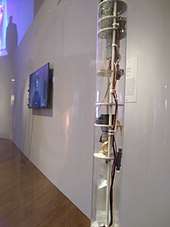MIT Senseable City Lab
The MIT Senseable City Laboratory aims to investigate and anticipate how digital technologies are changing the way people live and their implications at the urban scale. Director Carlo Ratti founded the Senseable City Lab in 2004 within the City Design and Development group at the Department of Urban Studies and Planning, as well as in collaboration with the MIT Media Lab. The Lab's mission states that it seeks to creatively intervene and investigate the interface between people, technologies and the city. Recent projects include "The Copenhagen Wheel"[1] which debuted at the 2009 United Nations Climate Change Conference, "Trash_Track" [2] shown at the Architectural League of New York and the Seattle Public Library, "New York Talk Exchange" [3] featured in the MoMA The Museum of Modern Art, and Real Time RomeReal Time Rome included in the 2006 Venice Biennale of Architecture.
The Lab's work draws on diverse fields such as urban planning, architecture, design, engineering, computer science, natural science and economics to capture the multi-disciplinary nature of urban problems and deliver research and applications that empower citizens to make choices to make a better liveable urban experience. Among the Lab's partners are a group of corporations, including AT&T, General Electric, Audi, ENEL, SNCF as well as cities such as Copenhagen, London, Singapore, Seattle, and Florence. At present, 31 researchers are working on activities sponsored by these industrial and municipal partners.
In 2010 the Lab will open a new research center in Singapore as part of a $35 million MIT-led initiative on the Future of Urban Mobility.[4]
Approach
The Senseable City Lab begins its project and research work with a vision for an urban future, or "urban demo". This vision is tailored to a particular city's needs and can be motivated by the challenges a place may be confronting, or by opportunities for providing new experiences or services due to advances in digital technologies. Urban demos are designed to be showcased at large public events and exhibitions to stimulate debate between citizens, public administrators, and industry. Following an urban demo, the Lab typically engages in more traditional academic research - analyzing the data that has been collected and producing research papers.
Achievements

Since 2004, the Senseable City Lab has grown rapidly reaching 35 completed projects by 2009 with a turnover of 63 researchers from all over the world. Lab researchers have produced 166 scientific publications in high-impact academic journals such as "Eigenplaces: analysing cities using the space-time structure of the mobile phone network".[5] The Lab's design work has been exhibited in some of the world's leading venues including the Venice Biennale, MoMA The Museum of Modern Art, the 2008 Zaragoza World Expo, the Architectural League of New York, Design Museum Barcelona, the Canadian Centre for Architecture and the MIT Museum. The Lab's work have been recognized in TIME Magazine's Best Invention of the Year 2007,[6] Esquire Magazine's Best and Brightest 2008,[7] Blueprint Magazine's List of 25 Who Will Change the World of Design in 2010,[8] and Thames and Hudson's 2009 List of Innovators Shaping Our Creative Future. Also, over 1,000 press outlets worldwide have covered the Lab's projects including the BBC, CNN, New York Times, Le Monde, Financial Times, TIME, The Economist, National Geographic, Boston Globe, Seed, Wired, Metropolis, Domus, Discovery Channel and many more. In January 2009, Director Carlo Ratti represented the Lab as a delegate to the World Economic Forum in Davos. In 2011, he presented at TED in Longbeach.
References
- For Bicyclists Needing a Boost, This Wheel May Help, NYT, December 14, 2009
- Following Trash and Recyclables on Their Journey, NYT, September 16, 2009
- New York and the Vanguard of Digital Design, NYT City Room blog, February 22, 2008
- MIT News Office, January 5, 2010
- Environment and Planning B: Planning and Design 36(5)
- Best Inventions of 2007, TIME
- Four Innovative Mapmakers Reinventing the Very Idea of Maps, Esquire, December 9, 2008
- Change in 2010, Blueprint, December 17, 2009 Archived March 16, 2010, at the Wayback Machine